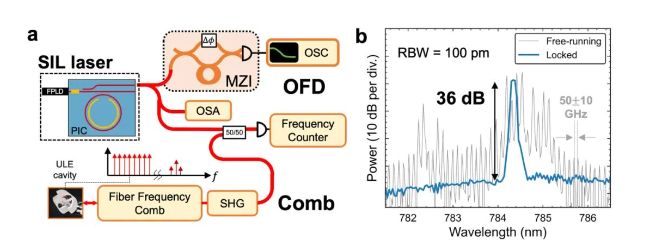Quantum communication: narrow linewidth lasers
Narrow linewidth laser is a kind of laser with special optical properties, which is characterized by the ability to produce a laser beam with a very small optical linewidth (that is, narrow spectrum). The line width of a narrow linewidth laser refers to the width of its spectrum, usually expressed in the bandwidth within a unit frequency, and this width is also known as the “spectral line width” or simply “line width”. Narrow linewidth lasers have a narrow line width, usually between a few hundred kilohertz (kHz) and a few megahertz (MHz), which is much smaller than the spectral line width of conventional lasers.
Classification by cavity structure:
1. Linear cavity fiber lasers are divided into distributed Bragg reflection type (DBR Laser) and distributed feedback type (DFB Laser) two structures. The output laser of both lasers is highly coherent light with narrow linewidth and low noise. DFB fiber laser can achieve both laser feedback and laser mode selection, so the output laser frequency stability is good, and it is easier to obtain stable single longitudinal mode output.
2. Ring-cavity fiber lasers output narrow-width lasers by introducing narrow-band filters such as Fabry-Perot (FP) interference cavities, fiber grating or sagnac ring cavities into the cavity. However, due to the long cavity length, the longitudinal mode interval is small, and it is easy to jump mode under the influence of environment, and the stability is poor.
Product Application:
1. Optical sensor Narrow-width laser as an ideal light source for optical fiber sensors, by combining with optical fiber sensors, can achieve high-precision, high-sensitivity measurement. For example, in pressure or temperature fiber optic sensors, the stability of the narrow linewidth laser helps ensure the accuracy of the measurement results.
2. High-resolution spectral measurement Narrow linewidth lasers have very narrow spectral line widths, making them ideal sources for high-resolution spectrometers. By selecting the right wavelength and linewidth, narrow linewidth lasers can be used for accurate spectral analysis and spectral measurement. For example, in gas sensors and environmental monitoring, narrow linewidth lasers can be used to achieve accurate measurements of optical absorption, optical emission and molecular spectra in the atmosphere.
3. Lidar single-frequency narrow line-width fiber lasers also have very important applications in liDAR or laser ranging systems. Using a single frequency narrow line width fiber laser as a detection light source, combined with optical coherence detection, it can build a long distance (hundreds of kilometers) liDAR or rangefinder. This principle has the same working principle as OFDR technology in optical fiber, so it not only has very high spatial resolution, but also can increase the measurement distance. In this system, the laser spectral line width or coherence length determines the distance measurement range and measurement accuracy, so the better the coherence of the light source, the higher the performance of the whole system.

Post time: Apr-14-2025





